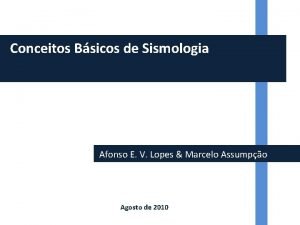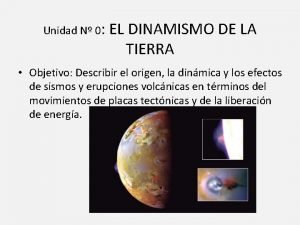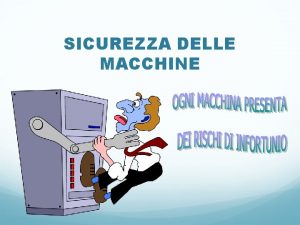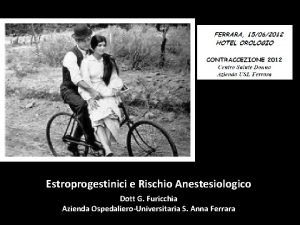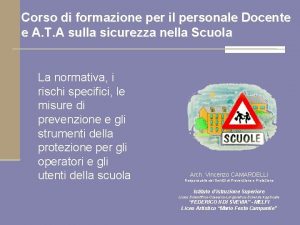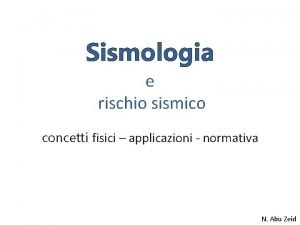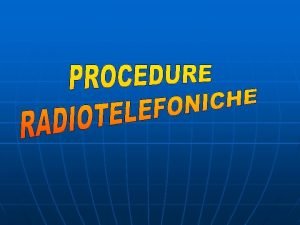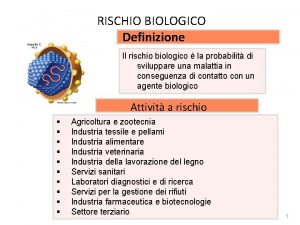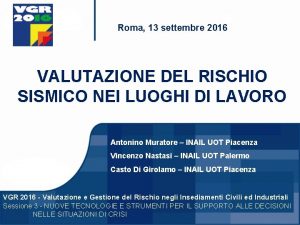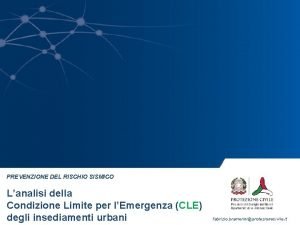Sismologia sismologia e rischio sismico Introduzione tipo onde










- Slides: 10

Sismologia sismologia e rischio sismico Introduzione: tipo onde elastiche 2018 -2019 Parte 03 Diapositive Power Point con animazioni

Blind Thrust Fault Earthquake Rupture Animation (Northridge, 1994) Brad Aagaard, USGS http: //pasadena. wr. usgs. gov/office/baagaard/research/animations. html The fault rupture will be visible in the animation. Displacements (magnified 3000 times) will be visible by the movement of the mesh from the model. The amplitude of motions and seismic waves is color coded according to ground velocity. Note the rupture along the fault over time from the deepest extent of the fault. Animazione Illustra defomrmazione (spostamento esagerazione 300 x) Visibile con il movemento della griglia Ampiezza: velocità di movimento della particelle nel piano verticale (in m/s) Le onde sono generate dalla propagazione della faglia A velocità media di circa 3. 2 -3. 5 km/s http: //web. ics. purdue. edu/~braile/new/Aagaard. Blind. Thrust. Animation. ppt , Also: http: //web. ics. purdue. edu/~braile/edumod/tsunami/Blind. Thrust. Slice. gif

Blind Thrust Fault Earthquake Rupture Animation – Brad Aagaard, USGS http: //pasadena. wr. usgs. gov/office/baagaard/research/animations. html The fault rupture will be visible in the animation. Displacements (magnified 3000 times) will be visible by the movement of the mesh from the model. The amplitude of seismic waves is color coded according to ground velocity. Note that slip along the fault plane (deformation releasing elastic energy) generates seismic waves at every point along the fault plane that ruptures during the earthquake, not just from a single point (focus or hypocenter).

Onde sismiche: di volume e di superficie (http: //web. ics. purdue. edu/~braile/new/Seismic. Waves 4 Types. ppt) Deformation propagates. Particle motion consists of alternating compression and dilation. Particle motion is parallel to the direction of propagation (longitudinal). Material returns to its original shape after wave passes. Deformation propagates. Particle motion consists of alternating transverse motion, perpendicular to direction of propagation. Transverse motion can be in any direction. Material returns to its original shape after wave passes. Deformation propagates. Particle motion consists of elliptical motions (generally retrograde elliptical) in the vertical plane and parallel to the direction of propagation. Amplitude decreases with depth. Material returns to its original shape after wave passes. Deformation propagates. Particle motion consists of alternating transverse motions. Particle motion is horizontal and perpendicular to the direction of propagation (transverse). Amplitude decreases with depth. Material returns to its original shape after wave passes.

Onde sismiche: di volume P - animazione Deformation propagates. Particle motion consists of alternating compression and dilation. Particle motion is parallel to the direction of propagation (longitudinal). Material returns to its original shape after wave passes.

Onde sismiche: di volume S - animazione Deformation propagates. Particle motion consists of alternating transverse motion. Particle motion is perpendicular to the direction of propagation (transverse). Transverse particle motion shown here is vertical but can be in any direction. However, Earth’s layers tend to cause mostly vertical (SV; in the vertical plane) or horizontal (SH) shear motions. Material returns to its original shape after wave passes.

Rayleigh Wave (R-Wave) Animation Deformation propagates. Particle motion consists of elliptical motions (generally retrograde elliptical) in the vertical plane and parallel to the direction of propagation. Amplitude decreases with depth. Material returns to its original shape after wave passes.

Onde sismiche di superficie: Rayleigh “R” - animazione Courtesy of Dr. Dan Russell, Penn State University Induce movimento di tipo retrogrado (antiorario) con ampiezza decrescente verso il basso (profondità). Ha due componenti di movimento delle particelle: verticale ed orizzontale

Onde sismiche di superficie: L - animazione Propagazione onde Love. Induce un movimento delle particelle in direzione trasversale a quella di propagazione. Il movimento delle particelle è su un piano orizzontale. Al fine di apprezzare il movimento delle particelle occorre fissare l’asse Y quando viene interessato dalle deformazioni. L’Ampiezza decresce con la profondità. Il materiale essendo elastico le deformazioni indotte non sono permanenti

Terremoti == Tipologia di onde elastiche vibrazioni prodotte ? sottosuolo ? Costruzione Materiale e progettazione onde superficiali dannose onde secondarie «S» dannose onde primarie «P» generalmente non dannose Onde «S» e onde di superficie le onde arrivano dal 10 basso
